Photo: The head of a large Texas Indigo Snake ( (Drymarchon melanurus erebennus).
After at least 50 years, I finally once again saw a Texas Indigo Snake (Drymarchon melanurus erebennus) on our farm. But first:
A DISCLAIMER (well…maybe, you’ll have to read more to find out what is it)!
Many online resources say something similar to what https://www.reptilefact.com/texas-indigo-snake.html says, “Found in Texas and almost everywhere in Mexico, the Texas Indigo Snake is a large size snake that is a member of the colubrid family. They are non-venomous and have been declared as a threatened species by the US state of Texas.” Note the “threatened” status. I, too, thought it was considered threatened by both the State of Texas and the US Government. Apparently, we are all wrong. First, I searched the Texas Parks and Wildlife website and didn’t find the Texas Indigo Snake listed as either threatened or endangered. Here’s a link to the listing, check it yourself:
Then, I went to another Texas Parks & Wildlife page:
Guess what it said?!?! (If you go to the above link, you’ll have to scroll down a bit to see it) “The Texas indigo snake, Drymarchon melanurus erebennus, is a subspecies of the Eastern indigo snake. It is listed as threatened in Texas and cannot be hunted or killed.” (As an aside, below that paragraph are some cool photos of an Indigo eating a Western Diamondback Rattlesnake (Crotalus atrox).) (Another aside: If you are reading this a while from the time that I published it, the text may have changed. As you’ll see later in this blog, the text is wrong on a couple of points and it might have been corrected.)
So, in an abundance of caution I also checked the US Fish & Wildlife Service where, lo and behold, I found the Eastern indigo snake (Drymarchon corais couperi) listed (see https://ecos.fws.gov/ecp0/profile/speciesProfile?spcode=C026).
Something worried me. Did you notice the difference in the names? Our Indigo, apparently Drymarchon melanurus erebennus, was not listed. And did you notice that Texas Parks & Wildlife called our Indigo a subspecies of the Eastern Indigo? Our Indigo, according to the State of Texas, is a subspecies, erebennus, of the species Drymarchon melanurus. The US Fish & Game Wildlife Service places the Eastern Indigo as a subspecies, couperi, of the species Drymarchon corais. I always thought the Eastern and Texas Indigos were subspecies of the same species. Wondering what the deal was, I went to our go-to taxonomic source, the Integrated Taxonomic Information System (https://itis.gov/). When I selected “scientific name” and typed in “Drymarchon”, here’s what I got:
Drymarchon Fitzinger, 1843 – valid – Indigo Snakes |
|
| Drymarchon caudomaculatus Wüster, Yrausquin and Mijares-Urrutia, 2001 – valid | |
| Drymarchon corais (F. Boie, 1827) – valid – Indigo Snake, Yellow-tail Cribo | |
| Drymarchon corais corais (F. Boie, 1827) – invalid – Indigo Snake, Yellow-tailed Cribo | |
| Drymarchon corais couperi (Holbrook, 1842) – invalid – Eastern Indigo Snake | |
| Drymarchon corais erebennus (Cope, 1860) – invalid – Texas Indigo Snake | |
| Drymarchon corais orizabensis (Dugès, 1905) – invalid | |
| Drymarchon corais rubidus H. M. Smith, 1941 – invalid | |
| Drymarchon corais unicolor H. M. Smith, 1941 – invalid | |
| Drymarchon couperi (Holbrook, 1842) – valid – Eastern Indigo Snake, Blue Indigo Snake, Blue Bull Snake | |
| Drymarchon kolpobasileus Krysko, Granatosky, Nuñez and D. J. Smith, 2016 – valid – Gulf Coast Indigo Snake | |
| Drymarchon margaritae Roze, 1959 – valid – Margarita Indigo Snake | |
| Drymarchon melanurus (A. M. C. Duméril, Bibron and A. H. A. Duméril, 1854) – valid – Middle American Indigo Snake, Blacktail Cribo | |
| Drymarchon melanurus erebennus (Cope, 1860) – valid – Texas Indigo Snake | |
| Drymarchon melanurus melanurus (Cope, 1860) – invalid | |
| Drymarchon melanurus melanurus (A. M. C. Duméril, Bibron and A. H. A. Duméril, 1854) – valid | |
| Drymarchon melanurus orizabensis (Dugès, 1905) – valid | |
| Drymarchon melanurus rubidus H. M. Smith, 1941 – valid | |
| Drymarchon melanurus unicolor H. M. Smith, 1941 – valid | |
It looks like a real mess! But, for our purposes, note these two lines from the listing above:
| Drymarchon melanurus erebennus (Cope, 1860) – valid – Texas Indigo Snake |
| Drymarchon corais erebennus (Cope, 1860) – invalid – Texas Indigo Snake |
ITIS says the Texas Indigo is not a subspecies of Drymarchon corais. Instead, it is a subspecies of Drymarchon melanurus. So, Texas Parks & Wildlife was wrong when it said, “The Texas indigo snake, Drymarchon melanurus erebennus, is a subspecies of the Eastern indigo snake.” But, was it right when it said, “It is listed as threatened in Texas…?” That is the question.
So, now I knew the Texas Indigo is a subspecies of the Central American Indigo and not of the Eastern Indigo. But, is it threatened? Faced with conflicting information from Texas Parks & Wildlife, I decided to call them for clarification. When I asked about the status of the Texas Indigo, I was transferred to an extension. No answer, but I did go to voicemail. I left my question. After a few days I got the answer via my voicemail. According to the message, in March of this year (2020), the Texas Indigo was reclassified as “non-commercial” from “threatened.” The message continued, saying that as a non-commercial species the Texas Indigo can be captured for personal use, but cannot be sold. Wanting more clarity, I searched the Texas Parks & Wildlife site for a definition of “non-commercial.” No luck. So back to the phone.
Once again, I went to voicemail and left my question. I was referred via a voicemail answer to my call to a person who was out of the office for a few days, but her message included her email address. I emailed, asking for a clarification concerning “non-commercial” status. After a few days I got a message providing a link to the Texas statute (law) describing this. For those who want to know more, here’s the link:
https://texreg.sos.state.tx.us/public/readtac$ext.ViewTAC?tac_view=5&ti=31&pt=2&ch=65&sch=O&rl=Y
It turns out the Texas Indigo is not threatened as of March 2020, but as a non-commercial species collecting it for your own personal use requires a permit. Furthermore, the permit does not allow the sale of trade of the snake. The conclusion that the Texas Indigo is not threatened is important to me since I don’t want to be accused of capturing a threatened species. Why? Because here’s what Texas has to say (see https://tpwd.texas.gov/huntwild/wild/wildlife_diversity/nongame/listed-species/species-protection.phtml):
“The ESA protects endangered and threatened species and their habitats by prohibiting the “take” of listed animals and the interstate or international trade in listed plants and animals, including their parts and products, except under federal permit. It is unlawful for a person to take a listed animal without a permit. Take is defined as “to harass, harm, pursue, hunt, shoot, wound, kill, trap, capture, or collect or attempt to engage in any such conduct.” Through regulations, the term “harm” is defined as “an act which actually kills or injures wildlife. Such an act may include significant habitat modification or degradation where it actually kills or injures wildlife by significantly impairing essential behavioral patterns, including breeding, feeding, or sheltering.”
Finally, we get to my DISCLAIMER! While I do not have a permit to collect a Texas Indigo, I merely rescued the pictured snake from our two German Shepherd Dogs, Oso and Maya. They consider snakes to be deadly enemies best quickly dispatched. The dogs cornered the snake against one of our greenhouses. I rescued it before they could inflict any damage. Fortunately, I had time to affect the rescue since the dogs are cautious about any snake species they don’t know. They, eagerly and without pause, attack Texas Rat Snakes (Elaphe obsoleta lindheimeri) and Diamondback Water Snakes (Nerodia rhombifer), both non-venomous; but don’t attack Western Diamondback Rattlesnakes (Crotalus atrox) and our local Copperheads (Agkistrodon contortrix laticinctus), both venomous snakes. When encountering the latter two species, the dogs stay back several feet and make their distinctive “bad snake bark.” Their caution about attacking a snake they didn’t know allowed me to get to it first. Since I was alone with the snake and dogs, I decided to carry the snake to the house where Susie (wife and business manager) could call our son, Carl, to come help secure the dogs while I released the snake.
While Indigos are large, powerful snakes, they are also very docile. On the trip to the house, the snake opened his mouth once, but didn’t try to bite me. He did squirm a bit but quickly relaxed and was calm. At the house Susie called Carl who lives across the road. While waiting for Carl, Susie took some photos. When Carl arrived, he took a few more. The snake didn’t seem much concerned about me, but every time one of the dogs approached him, he puffed up his neck and vibrated his tail. Perhaps wild canids like coyotes are major enemies and the dogs reminded him of them.
Once the dogs were secured, I took the snake back to the greenhouses to release it. When I placed it on the ground, the snake raced off into cover at a surprisingly fast pace (can snakes, which don’t have legs, have a “pace?”).
I’m hopeful the Indigo sticks around. This has been an active rattlesnake year, with eight sighted already and six relocated from work areas to one of our pastures. Twice recently we’d seen a Western Diamondback Rattlesnake (Crotalus atrox) near our greenhouses that we had not been able to catch for relocation. I’m hopeful the Indigo will catch and eat it (more about this later).
Before I get into some Texas Indigo natural history, why had it been at least five decades since I’d seen an Indigo on the farm? Three factors have contributed to Indigos becoming rare in Texas. First, prior to the Endangered Species Act the Indigo was over-collected by hobbyists. It is a large, impressive, and fairly docile snake, making it a favorite of collectors. Second, Indigoes have large home ranges often including increasingly busy roadways. This leads to squished snakes, and I’ve seen large one dead on the road about three miles away. Finally, many of the farms and ranches in the area have been split up for development, placing the snakes too close to people who think the only good snake is a dead snake. Most old-time farmers and ranchers knew Indigoes are beneficial. A common saying was, “If it’s indigo, let it go.” They wouldn’t think of killing an Indigo. Why did they like them? Indigoes are non-venomous. But, more importantly to farmers and ranchers, Indigoes are apparently immune to pit viper venoms, which they relish as food.
Now for some Texas Indigo natural history:
As can be seen from the photos below, the Texas Indigo Snake is mainly black with shiny iridescent scales. The belly ranges from gray to almost pink to bluish-gray. They grow large. The one I rescued was at about six feet (1.8 m) long. They grow to length of nine feet (2.75 m), making it the USA’s largest native snake.

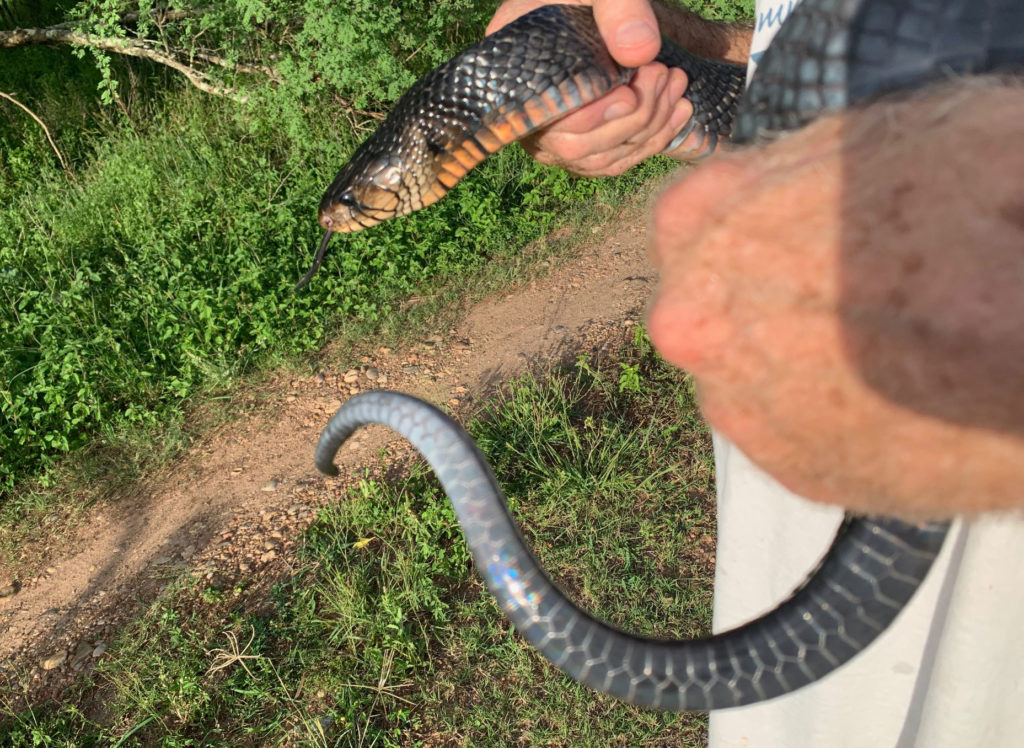
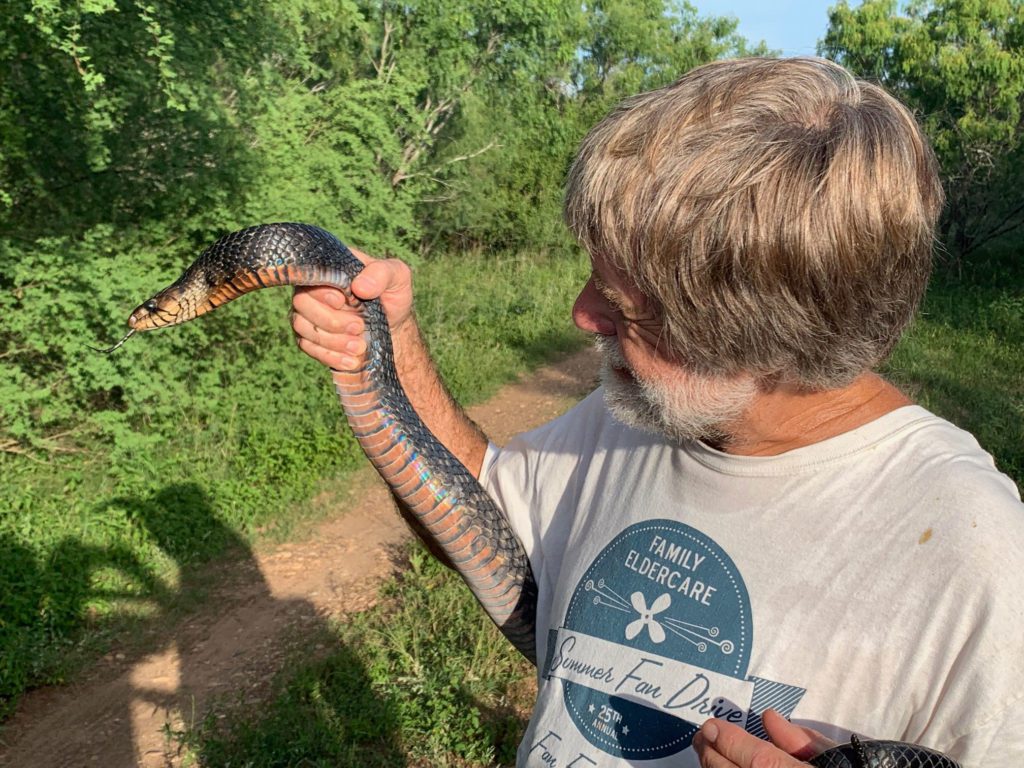
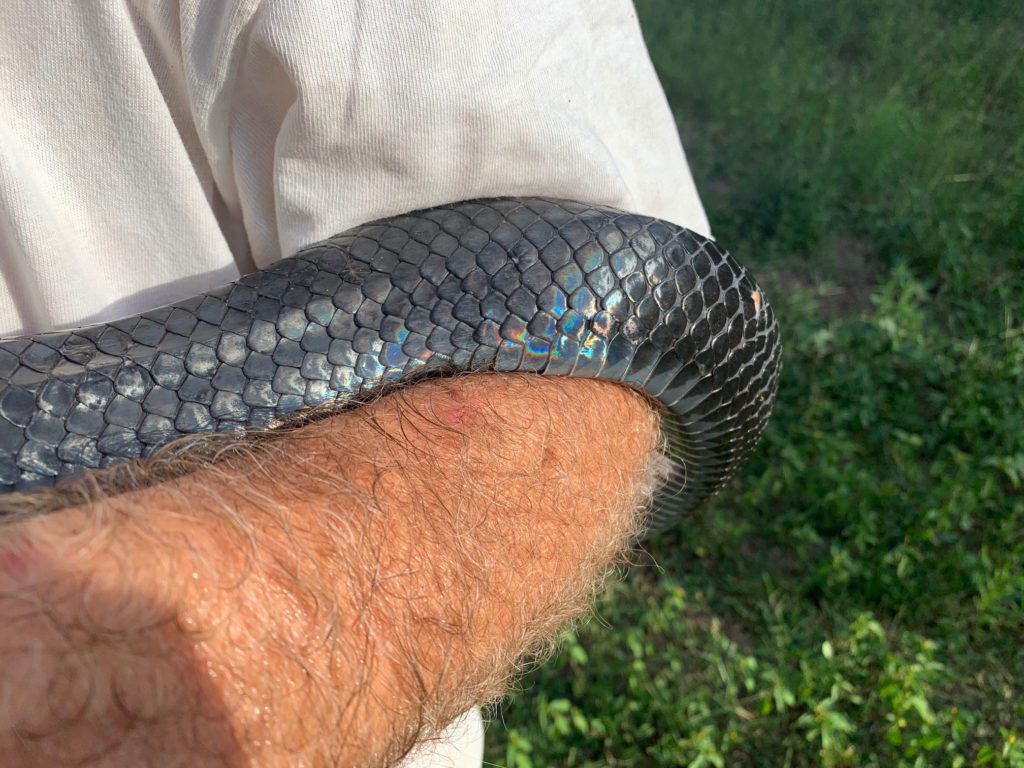
Indigoes are mostly diurnal, meaning they are active during the day. They hunt and devour everything small enough to eat. Their diets include small mammals, birds, lizards, frogs, turtles, eggs, and other snakes, including rattlesnakes. (For photos of this go back and read my Disclaimer. There is a link to a site that has some. Maybe next time you won’t skip parts of my blogs, there just might be something interesting buried there.)
Like the other large snake in our area, the Coachwhip (Masticophis flagellum testaceus), they often take shelter in abandoned animal burrows.
Texas Indigoes mate in the fall or winter. In the spring, females lay clutches of about a dozen eggs, which hatch in about three months. The neonates are large, about 25 inches (~0.65 m) in length.
The Texas Indigo snake is found in the range shown by the map below, usually near permanent streams. For their Texas range take a peek at this map from: https://www.reptilefact.com/wp-content/uploads/2017/12/Texas-Indigo-Snake-Range.jpg.
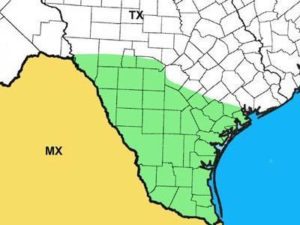
Note that Goliad County (look it up in a mapping program!) is near the northeastern edge of the Texas Indigo’s range.
Since our farm is in the Texas Indigo’s historical range and it was here when I was a child, I had been hoping it would return to the farm. That hope had been encouraged by my sightings of two Indigoes about three miles away and my sister, a mile away, had a resident Indigo for the past three or four years.
The presence of the rescued Indigo might explain the sudden absence of Copperheads in our yard. From seeing dozens every week in previous years, we only have seen four this summer. If you are interested in our Copperheads, here are some blogs about them.
https://goliadfarms.com/creepy-copper-the-copperhead-snake/
https://goliadfarms.com/copperhead-eating-lizard/
https://goliadfarms.com/copperhead-eating-a-cicada/
https://goliadfarms.com/copperhead-hunting-a-cicada/
https://goliadfarms.com/copperhead-in-tree/
If the Indigo is responsible for the recent dearth of Copperheads, maybe it will also reduce our rattlesnake population a bit. Interestingly, I’ve noticed our gopher (Geomys personatus) population is much reduced. I wonder if the Indigo is contributing to that.
Just to recap: I rescued a Texas Indigo, which is NOT a threatened species under the Endangered Species Act. While the Texas Indigo is considered a non-commercial species requiring a permit to capture, again I rescued the snake and released him as soon as practicable. Finally, I’m pleased to see Indigoes return to our farm.
Postscript: Just a few days ago, I saw another Indigo, a four-footer. The dogs and I were returning from the feedstore and both Oso and Maya were secure in the van. I was opening the gate at the road and saw the young snake about fifty feet (~15 m) away crawling toward me on the lane to our house. It also saw me and took off into the woods. So, maybe we have a sustainable breeding population now.

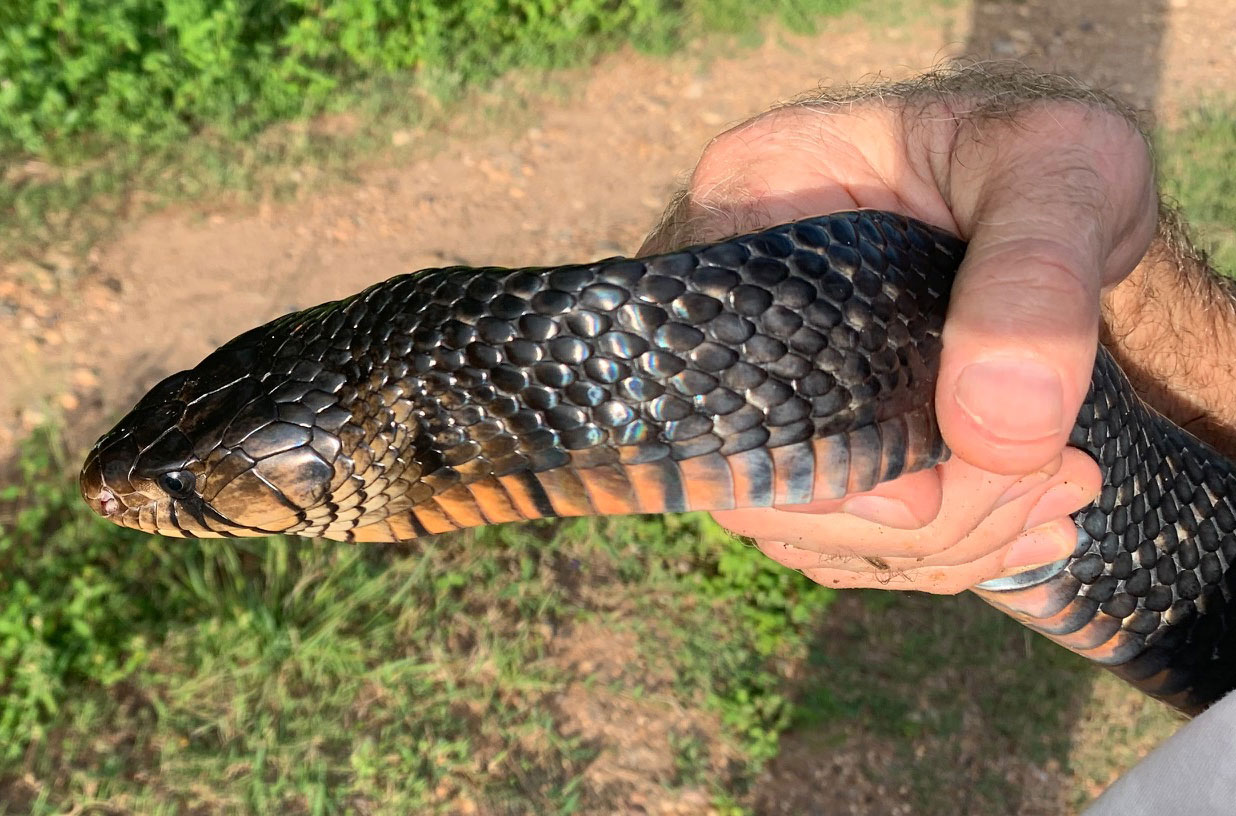
Greg says
Nice story about the indigo snake. Funny I saw your story yesterday and today I come across this video out of the blue. Never heard of this snake before yesterday and then I see two articles on it in one day! Beautiful snake! Thanks for sharing. https://www.facebook.com/prehistoricpets/videos/179897670476338
Charles Clapsaddle says
Greg,
Nice coincidence. The video is about the Eastern Indigo, which is now considered a separate species from the Texas Indigo, but they are incredibly similar. The Eastern Indigo is listed as threatened while the Texas Indigo is not, although keeping them requires a permit.
Thank you for providing the link to that video.
Charles
Dan McPherson says
I like to buy a baby indigo snake.
Charles Clapsaddle says
Dan,
It’s not legal to sell or trade Texas Indigoes in Texas.
Charles
Rand Alkire says
I am not a snake person, but this was certainly an interesting story. Wow. What a big beautiful snake.
Charles Clapsaddle says
Rand,
He is a very impressive animal. Since he’s been around our Diamondback Rattlesnakes and Copperheads have disappeared.
Charles
Eric Brodersen says
Thanks for taking the time to write this. I found it very interesting.
Charles Clapsaddle says
Eric,
Thank you. Indigos are very interesting snakes.
Charles
Kasey says
Thank you for the info! Such a good story! We are new to East Texas and I really wish we had them here. We had 5 copperheads already. Wish we had a beneficial snake to help with the population!
Michael says
Charles,
Thank you so very much for your beautiful and inspiring story! I would literally give an arm or a leg to be able to own a pair of either the Texas Indigo or the Eastern Indigo snakes. Long before they were declared an endangered or as in your case with the Texas version a critical category I had dreamed of owning and propagating them! I am talking about nearly 60 years ago! Unfortunately I had parents who defied my ‘urges’ prohibited me from having more than a couple of bullfrogs, Tiger salamanders and the one Northern Water snake I had for a time mysteriously disappeared!
One of my most tragic “reptilian” childhood memories was when my mother and grandmother brutally MURDERED a perfectly harmless large Fox snake… throwing a hatchet, rocks and even though it left a trail of blood still managed to crawl away and die in the nearby cornfield!!!!! This was in an area of Northern Illinois where there had never been a sighting of a poisonous snake for centuries!!!
The closest that I can come to having a snake as magnificent as the indigo snake is the California King Snake. Yes there is something to be said about the “beauty” of this snake it does not come even close to the Indigo Snakes!
My girl has a story worth telling:
Originally while Carole and I were making a tour of Cuyamaca Rancho State Park… as we were just above Cuyamaca Lake there was this snake crossing the road right in front of us! Of course I screeched to a halt and immediately got out and took her up in my hands. She was so beautiful that I justified to myself that if I had continued or perhaps another motorist had been in my place she would have been “road-kill”…therefor I justified taking her life into my possession…as though saving her life entitled me to make her mine.
I (we) took her home and kept her for a time but she managed to escape!!! In the duration of her “escape” she managed to have numerous offspring. (Obviously when we rescued/captured her she had been gravid)! So we had numerous beautiful little king snakes in our yard.
I managed to happen upon my “queen” Ca King snake and captured her once again. But obviously she was much more clever than I… again she escaped.
Months passed… perhaps even a year or more when I found and “captured” her once again. Only this time I noticed that part of her tail had been severed… I flashed back to a moment when I had discovered/realized another escape. The slider door had been open a few inches… I had slammed it shut… now my ‘sixth sense’ told me that she was almost completely out when I had slammed the slider door on her tail!!!!!
Obviously it was my/our karma that she would manage to escape yet again! Only this time I found her in the process of consuming a very large male San Diego Alligator lizard… It was obvious to me… no matter how much I love these lizards that I had to make a choice to either attempt to rescue this beautiful lizard that would have been harmed for the rest of its life or gently grasp and carry this snake that had literally become the LOVE OF MY LIFE to her hallowed chamber.
I really should create a better perspective! Yes I live quite close to the center of San Diego. However we have nearly 1/4 acre of land that is adjacent to a wildlife preserve (Chollas Creek preserve). I have developed our property to be completely wildlife friendly. We have had the California Chorus frogs (alias CA TreeFrogs) breeding here since 1989-90. Some of the specimens came from the very last vernal pool here on our mesa that was destroyed more than 20 years ago.
Surprisingly this ‘love of my life’ CA King snake’s progeny did not survive. Mostly I attribute this to the neighbors cats that would come into our yard and kill birds, lizards and yes snakes… not because they were hungry but because they relished ‘making the kill’!!!
The other possibility is we had Coach-Whip and California Two-Lined Racer snakes from the canyon below. Not only do they relish young birds, bird eggs, lizards, and rodents but will not turn down the opportunity of inhaling a small snake!
Of course there is no denial that if a teen/would be/momentary herpetologist would come across such a beautiful snake would of course want to possess it even without any knowledge needed to care for it!
The story does not end here!!! I went to feed her a couple of months ago and her “Queen’s Suite” had been vacated once again!!!!
This time I considered not pressing my luck any farther than already…. there she was only a few feet away… obviously taunting me… laughing at me that I might believe that I could completely possess her for myself!
I would love to post a picture of this incredible albeit mystical creature but I do not find anything here allowing me to do this!!!
Sincerely’
natureguy/Michael
Charles Clapsaddle says
Michael,
Thank you. By the way we now are posting on our YouTube channel. Today we did a short video on Fred the Toad.
Our nephew is a professor at Florida State studying venoms. He is very envious that we now have Indigos.
My parents put up with my snake collections. When I was about 9 or 10 my paternal grandfather visited from Iowa. He must have been pretty old at the time since my father was the youngest of 16 children. I had a collection of snakes in by bedroom and was warned to not startle my grandfather with a snake because he might have a heart attack so something. I was standing listening the adults when my grandfather turned to me and said, “Charles, I understand you have snakes. Could you bring them out? I kept snakes at your age too.” I was shocked since my father and his brothers were very anti-snake. My grandfather handled all my snakes.
My maternal grandparents had the farm my wife and I now own. To them the only good snake was a dead snake. I cringing everytime they hoed one to death. We are snake friendly. Have you read my blogs about copperheads?
California Kings are gorgeous snakes. Funny story about her escapades. Once, probably 20 years ago, Susie (wife) and I were driving out in West Texas on a two lane road. Across our lane was a very large Western Diamondback Rattlesnake, a large female. I stopped in the road to herd her into the deep grass next to the road. A pickup with farm workers came upon us, stopped, and grabbed hoes and shovels to kill her. I held them off long enough for the snake to escape into the grass where they were afraid to follow her. They obviously thought I was insane.
Email the photo of your snake at charles@goliadfarms.com and I’ll post it.
Charles
Michael says
Charles,
I forgot to mention… or maybe I did… how much I love water snakes! I have the last of four Brown water snakes that I purchased from a SE coast distributer that were obviously wild-caught!!! One died almost immediately and of the other three only one male has survived. Their body tone was absolutely pathetic upon arrival. It is only because I love this snake that I put up with this abuse!!! Even though making contact with this distributer and actually sending them pictures of the DOA and soon dead within a week or two of arrival they have never honored me! All I have ever got from them was emails for “discounts” and “special” deals for nothing that I would be interested in!
I share this with you in hopes that others may be more discriminatory concerning distributors of reptiles and amphibians. It behooves all of us to not make the same mistakes as I have! Only buy when you know they are captive bred animals!
As I can attest to!— More often than not wild-caught specimens have never been acclimated to captive conditions and therefore you get creatures like the Brown Water snakes that I got that were near death upon arrival!
ESPECIALLY the Brown Water snake which is notorious for being extremely temperamental….probably refused any food and possibly even water. If this idiot distributor could have figured it out… this is perhaps the most aquatic of all water snakes…could have held them in tanks of clean, filtered water… instead they were shriveled, starved and dehydrated when I got them!
PLEASE, PLEASE all of you who may read this take great care from whom you buy reptiles and amphibians…never make the same mistake as myself… not being able to find a particular species except from those who market exotic species that are caught in the wild! Not only should it be illegal; except under special circumstances; but as in my case these are most likely going to be specimens subjugated to extreme stress and in poor health by the time they arrive at your doorstep!!!
Sincerely,
natureguy22/Michael
Rick Marquette says
You do good work. I saw one today……..dogs walked pretty much right over it. Beautiful animal. Keep up the good work. I love snakes and nature. We live in Montgomery County
Charles Clapsaddle says
Rick, Indigoes are very impressive snakes. I’m glad they have returned up your way too.
Charles
Rick Marquette says
Sorry talking about an indigo…….
Charles Clapsaddle says
Rick, I figured that.
Charles
Beth says
Great article!!! Very interesting information and a pleasure to read. Thanks for sharing!
Charles Clapsaddle says
Beth, Thank you for reading it. We now have a YouTube channel and have done several snake videos.
Charles
Ben says
How the heck do your dogs know the difference between venomous and non-venomous snakes? That’s pretty cool
Charles Clapsaddle says
Ben,
I’m sorry for the tardy response. I just saw this message.
I think by smell. Rattlesnakes have an especially unique smell that I can detect from a distance. Copperheads have a different smell that I can detect up close (don’t ask). Dogs with their more sensitive noses can detect them from a distance.
Charles
Tricia Owen says
The smell makes sense. I’m just trying to picture the training exercises they learned the specific smells. Lol!
Charles Clapsaddle says
Tricia,
Most animals (including humans) instinctively recoil from rattles, so it would be easy for them to associate the sound and smell. Oso and Maya often warn me of rattlesnakes before the snakes rattle. As to copperheads, both dogs have been bitten by them, so I suppose they associate the pain with the smell. I don’t know how they know to leave coral snakes alone. Maybe they smell the venom.
Charles
Cary Boyd says
I am wanting to purchase a baby Texas Indigo. Eventually I want a pair. Right now I am breeding Ackies (Varanus acanthurus) in Tucson. I have a friend Dan Hillsman who is a Falconer in Austin. I told him to look you up. He was going to catch an Indigo on some land he owns down by Goliad. He is going there today Thursday July 14 to fly his birds and may drop by to see you. Please be courteous to him and tell him how he can purchase a baby Texas Indigo. Kind regards, Cary.
Charles Clapsaddle says
Cary,
Texas Indigoes can’t be sold or traded in Texas.
Charles
Cary Boyd says
I am looking to purchase one or two baby Texas Indigo snakes. I breed Varanus acanthurus in Tucson Arizona. Please get me in touch with someone who can assist me with this. I have a Falconer friend Dan Hillsman who says he sees them often near Goliad. He is to old to help me with this,and has his hands full with Perigrines. Please help me with this. Kind regards Cary
Charles Clapsaddle says
Cary,
Texas Indigoes can only be kept with a permit. The permit prohibits the sale or trade of the snake. We don’t collect or raise the Texas Indigo but do appreciate them being around.
Charles
Tek Watts says
Where is a link to apply/purchase a permit that would allow someone to catch/keep a Texas indigo?
Charles Clapsaddle says
Tek,
I wasn’t able to find a person to talk with, but here’s the link I would start with:
https://web_com_corr-tpwdtexas.govqa.us/WEBAPP/_rs/(S(tpsys0evingotnangme200ir))/supporthome.aspx?sSessionID=10424397PTFVYFZLWOB[HJYHHFXNDNEWFOGCFBSF&lp=2
Charles
Owen says
Charles,
GREAT WRITE UP! Thank you!
Years ago in when I lived in Aransas Pass a 7 footer was run over in front of our neighborhood. The guy who hit the snake was VERY distraught and knew this was a “good “ snake. Sad day.
Hopefully you all don’t have wild hogs running through your area. Our ranchito north of College Station has wild hogs and the hogs have decimated the snake population. Hopefully you don’t have hogs going after the indigos!
Charles Clapsaddle says
Owen,
It is sad to see such a pretty snake dead on a road.
We have wild hogs although their population in down some from a few years ago. We are seeing more Indigoes, so I suppose they are dealing with the hogs.
Charles